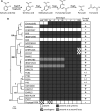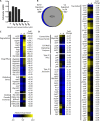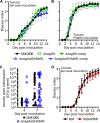Degradation of the Plant Defense Signal Salicylic Acid Protects Ralstonia solanacearum from Toxicity and Enhances Virulence on Tobacco
- PMID: 27329752
- PMCID: PMC4916378
- DOI: 10.1128/mBio.00656-16
Degradation of the Plant Defense Signal Salicylic Acid Protects Ralstonia solanacearum from Toxicity and Enhances Virulence on Tobacco
Abstract
Plants use the signaling molecule salicylic acid (SA) to trigger defenses against diverse pathogens, including the bacterial wilt pathogen Ralstonia solanacearum SA can also inhibit microbial growth. Most sequenced strains of the heterogeneous R. solanacearum species complex can degrade SA via gentisic acid to pyruvate and fumarate. R. solanacearum strain GMI1000 expresses this SA degradation pathway during tomato pathogenesis. Transcriptional analysis revealed that subinhibitory SA levels induced expression of the SA degradation pathway, toxin efflux pumps, and some general stress responses. Interestingly, SA treatment repressed expression of virulence factors, including the type III secretion system, suggesting that this pathogen may suppress virulence functions when stressed. A GMI1000 mutant lacking SA degradation activity was much more susceptible to SA toxicity but retained the wild-type colonization ability and virulence on tomato. This may be because SA is less important than gentisic acid in tomato defense signaling. However, another host, tobacco, responds strongly to SA. To test the hypothesis that SA degradation contributes to virulence on tobacco, we measured the effect of adding this pathway to the tobacco-pathogenic R. solanacearum strain K60, which lacks SA degradation genes. Ectopic addition of the GMI1000 SA degradation locus, including adjacent genes encoding two porins and a LysR-type transcriptional regulator, significantly increased the virulence of strain K60 on tobacco. Together, these results suggest that R. solanacearum degrades plant SA to protect itself from inhibitory levels of this compound and also to enhance its virulence on plant hosts like tobacco that use SA as a defense signal molecule.
Importance: Plant pathogens such as the bacterial wilt agent Ralstonia solanacearum threaten food and economic security by causing significant losses for small- and large-scale growers of tomato, tobacco, banana, potato, and ornamentals. Like most plants, these crop hosts use salicylic acid (SA) both indirectly as a signal to activate defenses and directly as an antimicrobial chemical. We found that SA inhibits growth of R. solanacearum and induces a general stress response that includes repression of multiple bacterial wilt virulence factors. The ability to degrade SA reduces the pathogen's sensitivity to SA toxicity and increases its virulence on tobacco.
Copyright © 2016 Lowe-Power et al.
Figures






Similar articles
-
Ralstonia solanacearum requires PopS, an ancient AvrE-family effector, for virulence and To overcome salicylic acid-mediated defenses during tomato pathogenesis.mBio. 2013 Nov 26;4(6):e00875-13. doi: 10.1128/mBio.00875-13. mBio. 2013. PMID: 24281716 Free PMC article.
-
The in planta transcriptome of Ralstonia solanacearum: conserved physiological and virulence strategies during bacterial wilt of tomato.mBio. 2012 Aug 31;3(4):e00114-12. doi: 10.1128/mBio.00114-12. Print 2012. mBio. 2012. PMID: 22807564 Free PMC article.
-
Ralstonia solanacearum Type III Effector RipAL Targets Chloroplasts and Induces Jasmonic Acid Production to Suppress Salicylic Acid-Mediated Defense Responses in Plants.Plant Cell Physiol. 2018 Dec 1;59(12):2576-2589. doi: 10.1093/pcp/pcy177. Plant Cell Physiol. 2018. PMID: 30165674
-
Ralstonia solanacearum, a widespread bacterial plant pathogen in the post-genomic era.Mol Plant Pathol. 2013 Sep;14(7):651-62. doi: 10.1111/mpp.12038. Epub 2013 May 30. Mol Plant Pathol. 2013. PMID: 23718203 Free PMC article. Review.
-
Molecular Dialog of Ralstonia solanacearum and Plant Hosts with Highlights on Type III Effectors.Int J Mol Sci. 2025 Apr 13;26(8):3686. doi: 10.3390/ijms26083686. Int J Mol Sci. 2025. PMID: 40332227 Free PMC article. Review.
Cited by
-
Ralstonia solanacearum promotes pathogenicity by utilizing l-glutamic acid from host plants.Mol Plant Pathol. 2020 Aug;21(8):1099-1110. doi: 10.1111/mpp.12963. Epub 2020 Jun 29. Mol Plant Pathol. 2020. PMID: 32599676 Free PMC article.
-
Metabolomics-mediated elucidation of rice responses to salt stress.Planta. 2023 Nov 3;258(6):111. doi: 10.1007/s00425-023-04258-1. Planta. 2023. PMID: 37919614 Review.
-
Pathogens pulling the strings: Effectors manipulating salicylic acid and phenylpropanoid biosynthesis in plants.Mol Plant Pathol. 2021 Nov;22(11):1436-1448. doi: 10.1111/mpp.13123. Epub 2021 Aug 19. Mol Plant Pathol. 2021. PMID: 34414650 Free PMC article. Review.
-
Gene editing of the E3 ligase PIRE1 fine-tunes reactive oxygen species production for enhanced bacterial disease resistance in tomato.Plant Cell. 2025 May 9;37(5):koaf049. doi: 10.1093/plcell/koaf049. Plant Cell. 2025. PMID: 40445949 Free PMC article.
-
SlS5H silencing reveals specific pathogen-triggered salicylic acid metabolism in tomato.BMC Plant Biol. 2022 Nov 29;22(1):549. doi: 10.1186/s12870-022-03939-5. BMC Plant Biol. 2022. PMID: 36443652 Free PMC article.
References
-
- Vidal S, Eriksson ARB, Montesano M, Denecke J, Palva ET. 1998. Cell wall degrading enzymes from Erwinia carotovora cooperate in the salicylic acid-independent induction of plant defense responses. Mol Plant Microbe Interact 11:23–32. doi: 10.1094/MPMI.1998.11.1.23. - DOI
Publication types
MeSH terms
Substances
Grants and funding
LinkOut - more resources
Full Text Sources
Other Literature Sources
